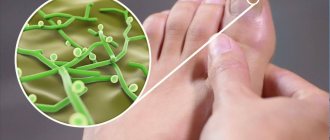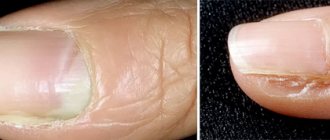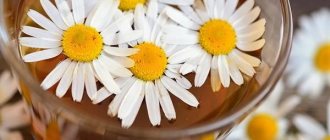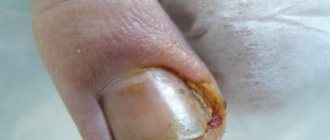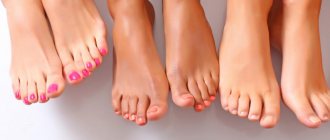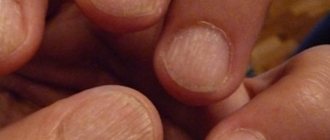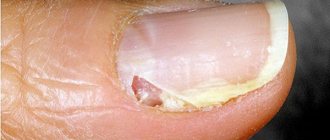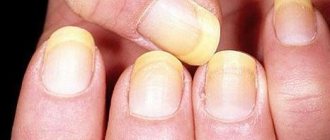What is mycosis of the nail plate of the skin?
Nail fungus, medical term onychomycosis. This is the most popular disease among people in which the nails begin to change color. The plate becomes dense and divided into several layers, becomes brittle, changes its texture and turns yellow. There is pain when moving.
It is caused by cracks that occur when the nail is affected by onychomycosis. Basically, the disease progresses slowly; without treatment, the fungus spreads to healthy nails and the disease becomes widespread. After the treatment is completed, the nails take a long time to return to their original appearance.
Onychomycosis is a dangerous disease and often recurs, so treatment should be carried out carefully and with consultation with a doctor. But even complete treatment does not guarantee complete recovery. About 20% become infected again and treatment must be carried out from the very beginning, since repeated infection affects the skin around the nail.
Types of infection
- Onychomycosis is a rather dangerous infectious disease, the seriousness of which lies in the speed of infection and the complexity of treatment. Three fungi influence the occurrence of the disease. Namely: yeast fungus, dermatophyte fungus and mold species.
- Dermatophytes are a common infection that affects the nail beds of the hands. Dermatophytes are Trichophyton schoenleini and Trichophyton violaceum. The latter option infects not only the nail plate, but also the skin and hair. Due to weak immunity, upon contact with a fungal pathogen, a large area of skin is affected.
As the growth of dermatophytes progresses, mycelium appears, which quickly invades the nails and skin. The mycelium of the fungus quickly destroys a living organism.
Yeast-type fungi infect the skin and mucous membranes . Nails are also subject to destruction. With a weakened immune system, the yeast fungus may not be acquired, but independently formed. Yeast subspecies include:
- Candida albicans.
- Candida tropica.
- Parapsilosis.
Important!
The most severe type is mold. Contains more than forty subspecies. It is very dangerous because it quickly penetrates a living organism and instantly destroys it. Mold fungus is very difficult to identify, since it has practically no manifestations.
In order for the diagnosis to be unambiguous, it is necessary to conduct a series of tests and take scrapings. The mold type of fungal infection also affects internal organs, leading to serious diseases . That is why it is necessary to treat the fungus in time, before it penetrates into the activities of other vital organs.
Onychomycosis is divided into the following types:
- Normotrophic type . It is easy to determine whether a person has it. The nail plate is thickened and changes color; after the appearance of peculiar stripes of a color different from the nail, destruction occurs.
- Hypertrophic type . It stands out because when affected, the entire nail is not deformed, but only along the edges. Changes color a little. Loss of the nail plate is possible without the listed symptoms.
- Atrophic type . This is a painful lesion of the nail, in which the nail plate gradually lags behind the nail and is accompanied by bleeding.
- Distal-lateral type . The most common fungal infection that can be found in both adults and children. It is characterized by yellowing of the nail plate and deformation of the nails at the edges. This is mainly a problem with fingernails. The impetus for the development of this type is reduced immunity. With insufficient care and treatment, complete loss of the nail plate is possible.
How to treat fingernail fungus, medications
Treatment in 80% of cases is protracted and difficult; it can last from two months to a year.
This process is always carried out by taking medications internally and using them externally. There is no miracle ointment that you apply once and everything will go away in nature, so treatment must be taken with particular seriousness, following the full course in accordance with the recommendations of the attending physician.
The doctor must determine the treatment tactics specifically for your case, taking into account the degree of damage, duration of the disease, and pathological changes that exist today.
A competent approach is the key to a quick and high-quality recovery!
Pills
They eliminate the cause of the disease from the inside, killing the pathogen itself, which lives and develops in the body. A course of antifungal drugs is prescribed, starting with a loading dose, gradually lowering it and reducing it to a minimum.
Important! Do not skip doses of medications and take them at the same time, no earlier than 12 hours after the last dose.
Medicines based on substances: terbinafine, flucanozole, clotrimazole...
Ointments
They act locally and effectively, it is recommended to apply not only to the nail, but also to the skin around it, as well as between the fingers, so that the fungus cannot spread to other areas of the hand. One ointment can be used for no more than two months, as resistance (addiction) to the active substance may develop, and it will simply stop working.
Medicines: canespor, miconazole, lamisil uno, exoderil, nystatin...
Drops
The principle of treatment is the same as that of ointment due to local action, but drops are considered more effective, they penetrate much deeper into the affected parts of the nail itself and the skin under it, which cannot be achieved with ointment, and the treatment process itself is faster.
Medicines: exoderil, clotrimazole, terbinafine, flucanozole...
Lucky
They are used exclusively in the early stages of diagnosing the problem, when the shape and density of the nail is not yet deformed; it can also be used for preventive purposes if someone in the family suffers from this disease.
Medicines: Demicten, Batrafen, Nylner...
Photo of hand fungus
Signs and symptoms of a fungal infection
It is the type of infectious agent that will characterize the signs of the fungus. It is worth noting that the volume of affected skin will tell how long ago the fungus has settled on the nail plate and how severe the disease is. The age factor plays an important role. Older people are more susceptible to various types of infections.
Fungus is no exception. The fact is that with age, the body’s natural resistance to infections decreases. As a result, the fungus spreads very quickly along the nail plates. Let's look at the main symptoms and signs of fungal infections.
- Normotrophic nail fungus . The first thing that happens is a change in the color of the nail plate. The thickness and condition of the nail remain normal. At the initial stage, dark yellow stripes and spots appear. The location of the lesion depends on the degree of infection of the nail. The fungus is characterized by the fact that the plate does not have the ability to stay on the bed and a person can intentionally or accidentally lose it while walking.
- Hypertrophic nail fungus . Due to the growth of scales, the nail enlarges and becomes 2–3 mm thicker. The plate turns yellow and loses its healthy shine. In case of complete infection of the nail, crumbling and destruction begins. The longer the time has passed since the onset of the lesion, the faster the process of nail loss occurs. The very first sign of infection with this type of fungus is pain when walking and a sensation of movement of the nail plate. Later the nail acquires a gray-yellow color.
- Atrophic lesion of fingernails . The primary symptom is a change in color. The nail plate turns brown. The shine and healthy appearance of the nail completely disappears. As the infection progresses, the plate begins to crumble. The last stage of the disease is the complete destruction of the nail and the development of necrosis. Atrophy gradually develops, starting from the outer end to the growth zone and nail fold. The base of the nail plate remains untouched by fungal infection for a long time. Infection occurs last.
- Lateral and distal fungus . Nail plate fungi with similar symptoms. The nail becomes yellow in color. If the nail infection is a mold fungus, the nail will turn blue or green. The nail begins to crumble and acquires a rough surface on the sides of the plate. The nail bed becomes partially exposed and gradually the nail lags behind the bed. Complete loss of the plate occurs, accompanied by pain. The most recent sign of this type is the discharge of pus from under the nail, even with light pressure.
- Proximal fungus . A rather rare lesion of the nail plate, which begins with a skin fold. Occurs mainly after a cosmetic cuticle removal procedure. The plate begins to turn white in the growth area. This is the spread of fungal spores. Gradually, the fungus spreads throughout the nail and destroys the entire plate.
- Total fungus . Types of lesions of the distal and proximal type destroy the nail quite quickly. First, the nail loses its healthy color and becomes dark yellow, then it begins to crumble. If therapy is not used, the plate is lost altogether. White superficial fungus. White-pink spots appear on the nail plate, which begin to crumble as the disease progresses. The final stage of the fungus is characterized by fine powder.
Without taking into account the clinical diversity of each type of fungal infection, several common symptoms can be identified, including:
- the nail gradually turns into powder;
- color change;
- the nail is divided into layers;
- pain in the nail plate area;
- itchy sensations;
- unpleasant smell.
Systemic drugs for oral administration
In severe cases of nail fungus, treatment on the hands at home involves taking systemic medications - tablets or capsules. Doctors will determine the frequency of use and duration of therapy on an individual basis.
Treatment of fingernail fungus with drugs increases the effectiveness to doctors, by carefully following the instructions - changing the dosage of drugs or the timing of therapy on your own is absolutely unacceptable. Rating of the most commonly prescribed fungicidal tablets:
- Ketoconazole;
- Griseofulvin;
- Itraconazole;
- Terbinafine;
- Micomas;
- Flucostat.
to determine the best remedy for fingernail fungus based on people's reviews - each case is unique, the susceptibility of microorganisms to systemic agents is different.
Causes of the disease, development and routes of transmission
There are three routes of transmission.
- Transmitted from the free edge of the nail. Pathology will develop under the nail. Hyperkeratosis provokes a deterioration in the binding properties of the nail plate with the bed and leads to nail loss.
- The dorsal part of the nail can only be affected by dermatomycetes. Nail loss occurs very quickly.
- The proximal cushion serves as a conductor quite rarely. The fungus settles on the matrix and from there destroys the collagen layers.
Important!
Most often this process occurs on the fingernails.
The cause is preliminary damage and destruction of the nail:
- Mechanical injuries.
- Chemical exposure, such as constant exposure to detergents.
- Items made of fabric containing synthetics.
- Excessive human sweating also provokes the development of fungus.
- Flat feet and short distance between the toes.
- Nail growth exceeding skin regeneration.
- Neglect of hygiene rules.
- A disorder of the immune system, in which the degree of protection of the body as a whole, including the nail plates, decreases.
- Phlebeurysm.
- Climate change. When moving and changing clothes, the body may not have time to adapt to climate change and wearing warm clothes and tight shoes contributes to the development of fungal infections.
- Age-related changes. In old age, nail nutrition and tissue regeneration deteriorate, the protective properties of nails decrease and they are more susceptible to infections.
- Gender. Namely, men get sick five times more often than women.
- Peculiar professions. Work associated with dust, humidity different from external humidity, air temperature, and gas pollution increases the risk of infection with fungal spores.
- Massage rooms, saunas, baths, as well as orthopedic rooms are breeding grounds for fungal infections.
- The presence of diabetes mellitus, thyroid pathology, excess weight, angiopathy.
- HIV infection causes fungal infection 5 times more often than other sources.
As for the routes of infection, this occurs mainly in places such as:
- Sauna.
- Bathhouse.
- Swimming pools.
- Places of general hygiene items. Namely towels, pumice stone, rug, slippers, washcloths.
- Cosmetic procedures in beauty salons that do not comply with sanitary and epidemiological standards.
Folk remedies
To cope with an infection, it is necessary to correctly identify the pathogen and make a diagnosis - treatment methods depend on this. Only a doctor can do this. Treatment of fingernail fungus using traditional methods:
- must be agreed with a dermatologist;
- becomes an addition to the prescribed medications;
- has the greatest effect when diagnosing infection at an early stage.
In this situation, the best remedies are:
- applications with novocaine solution at night;
- baths with sea salt and soda before applying ointments;
- rinsing the lesion with brewed green tea;
- ointment dressings with equal proportions of cranberry juice and Vaseline;
- compresses with lilac tincture in alcohol;
- baths with strong coffee;
- dressings with fresh crushed burdock leaves;
- treatment of purulent rashes with a swab with ammonia;
- ingestion of natural immunomodulators - tinctures of Eleutherococcus, ginseng, Chinese magnolia vine.
Soda
Treatment of fungus at home can be done using a product that is found in every kitchen. Baking soda, which has alkaline properties, counteracts the development of infection. When using it:
- the stratum corneum of the skin and nail plates soften;
- subsequent absorption of drugs improves;
- the stability of remissions increases;
- antiseptic treatment occurs;
- the skin dries out;
- the development of fungal infection stops.
Baking soda is included in the best folk recipes for nail fungus. You can prepare the product from a mixture of three tablespoons of the product with water, diluted to a thick paste. During the procedure:
- the composition is applied to pre-steamed plates from which the affected layer has been removed;
- lemon juice is dripped on top of the soda;
- leave for 5 minutes;
- wash off with soap and water;
- dried;
- apply medicinal ointment or varnish.
Before using local antifungal drugs, doctors recommend making baths from a mixture of three tablespoons of soda, five drops of iodine, dissolved in two liters of warm water. One of the best remedies using the product:
- pour 2 liters of water into a basin;
- add a spoonful of liquid soap;
- add two sodas;
- mix;
- keep your hands in the bath for 40 minutes;
- rinse with water;
- dry thoroughly;
- apply an antifungal agent prescribed by a doctor.
Tea mushroom
A homemade drink is one of the best folk remedies for fungus. It is prepared by infusing medusomyset in sweet tea leaves, a mucus-like mass called kombucha. For infectious lesions, a healing drink:
- increases immunity;
- softens nail plates;
- stops the proliferation of fungal spores;
- destroys colonies of pathogenic microorganisms.
The therapeutic antifungal effect is ensured by the presence of acids in the composition. You can use the liquid in which the fungus has developed for two months. According to the recipe you need:
- take 2 glasses of drink;
- let it simmer under low heat for two hours to increase the acid concentration;
- moisten a cotton pad with liquid;
- put a compress on the nail;
- wrap the top with polyethylene;
- make a bandage overnight.
You can use a jelly-like mass of medusomycetes against the fungus. There are recipe options for use:
- grind the kombucha to a pulp, rub into the nail plate;
- take a piece of medusomycete, apply it to the nail, cover it with polyethylene, make a bandage - this will enhance the effect of treatment;
- Carry out the procedure daily until symptoms disappear.
Celandine
This medicinal plant is considered poisonous and requires caution when using it and must consult a doctor. If handled carelessly, vomiting, convulsions, dizziness, and fainting are possible. Celandine has the best qualities for treating fungus on the hands:
- has an antibacterial effect;
- eliminates inflammation;
- regenerates tissue – promotes healing of cracks;
- relieves burning, itching.
Treatment is carried out until the symptoms of a fungal infection on the hands are eliminated and a new nail plate grows. In folk recipes it is recommended to use celandine in several forms:
- the juice of a freshly picked plant is applied to the affected nails and skin of the hands four times with an interval of 3 minutes, repeat twice a day;
- with a decoction of leaves and flowers, prepared from half a glass of the mixture, poured with boiling water - 250 ml, make hand baths;
- Apply a mixture of dry herbs and vegetable oil to the affected areas and apply night bandages until the condition improves.
Birch tar
This substance is considered one of the best for treating fungus on the hands. Its composition includes microelements that provide antiseptic, drying, analgesic effects, and resist pathogenic microorganisms. Dermatologists recommend using birch tar in the initial stages of mycosis of the hands and nails. Folk remedy helps:
- eliminate burning, itching;
- stop nail changes;
- relieve pain in the hands;
- heal cracks;
- prevent nail splitting.
When treating with birch tar, it should be noted that the product has a strong odor, can cause allergic reactions, and is contraindicated for dry skin. It is advisable to do a tolerance test before use. Among the best folk recipes:
- baths with a mixture of laundry soap and tar for 20 minutes;
- applying the medicinal product to pre-steamed legs, the surface of the skin between the fingers, palms, leaving for two hours;
- use of tar soap before lubricating surfaces with preparations recommended by the doctor.
- Nagiyev's wife Dmitry - the actor's personal life. Biography and photos of ex-wives Alisa Sher and Natalia Kovalenko
- Clothes storage - proper organization of space in a closet or room
- Difficulty nasal breathing without runny nose
Kalanchoe
The houseplant is popular among traditional healers and is used as one of the best remedies for treating skin infections. Fresh Kalanchoe juice has healing properties. When using it:
- a bactericidal effect is carried out;
- local immunity is activated;
- manifestations of fungal infection on the hands are eliminated.
You can achieve rapid growth of a healthy nail and healing of cracks if you lubricate the affected areas with juice from a freshly picked Kalanchoe leaf. It is good to use daily compresses for treatment. You can prepare an ointment and apply bandages with it until complete recovery. According to the recipe, you need to heat in a water bath:
- a mixture of equal parts of Kalanchoe juice and alcohol - 30 ml;
- lanolin – 50 g.
Herbs
Many medicinal plants are used in traditional healers' recipes due to their antiseptic and anti-inflammatory properties. Herbs must be brewed by adding a spoonful to a liter of boiling water. The prepared solution is diluted twice with water, a spoonful of sea salt is added and baths are made for 20 minutes. The best composition of the medicinal mixture:
- Oak bark;
- calendula;
- chamomile flowers.
You can prepare healing oil to counteract fungus on your hands. The resulting medicine is used to treat infected areas for a month in the morning and evening. Preparation of the composition continues for two weeks in a dark place. According to the recipe, you need to add to a glass of vegetable oil in grams:
- burdock root –10;
- dried calendula – 5;
- calamus root – 10.
Essential oils
According to dermatologists, these products are among the best for treating fungus on the hands. Before using essential oils, it is recommended to do an allergy test - apply a drop to the elbow. If there is no redness, you can use the drugs in several ways:
- apply to the surface in its pure form;
- make applications from a mixture of oils;
- add a few drops to the hand bath.
Any of these effects is carried out at least twice a day. The procedures are done until the nail is completely renewed or the symptoms of a skin infection are eliminated. Among the best drugs that fight fungus, increase local immunity, accelerate tissue regeneration, are essential oils:
- tea tree;
- cedar;
- pine trees;
- fir;
- eucalyptus;
- thymol;
- peppermint.
Diagnostics
Detection of the fungus occurs under a microscope, or rather its exact origin and degree of neglect. This is the only accurate diagnosis of this disease.
However, this test does not make it possible to identify the causative agent of a fungal infection. There are a wide variety of fungi, and many of them are not contagious species.
For accurate information, it is necessary to pass a culture test on a nutrient medium and isolate a culture of the fungus. But it is worth noting that only a competent laboratory technician who has studied the science of fungal infections and their life in a living organism can distinguish a fungus from one another. Specialists - mycologists use the diagnosis of fungal infections in the groin, foot, skin and nails.
Treatment of hand skin fungus
An acidic environment is detrimental to microbial spores. Among the best folk recipes for fungus on the hands is tomato juice. You can make baths and lotions from the drink for a quarter of an hour. To treat fungal infections use:
- against yeast microorganisms Candida – onion juice, grate, leave for 15 minutes;
- for lesions between the fingers - a mask of fresh mint leaves, grated with salt, leave for an hour.
You can make a tincture from pine needles and cones. To do this, pour 250 g of the mixture of components with a liter of alcohol, leave for 2 weeks without light, lubricate the affected areas twice a day. Among the best recipes is a homemade ointment, for the preparation of which you need to make a mixture and apply it at night for two weeks. Ingredients include (in tablespoons):
- vinegar – 2;
- glycerin – 1;
- alcohol – 1.
Effective medicines, ointments and preparations for quick relief from mycosis
Today there are a large variety of drugs that stop the growth of fungal spores and prevent infection of other nails. Let's consider the main ones:
- Fluconazole . Capsules that act from within the body. Prevents further growth of fungal infection.
- Terbinafine . Pills. They act quickly and stop fungal growth. But, after a year, a relapse of the disease may occur.
- Griseowulfin . Rarely used, but quite a strong drug that is active against dermatophyte fungi.
- Ketocanozole . The substance penetrates on the 12th day after taking the drug. The drug has a large number of side effects. That is why it can only be prescribed by a doctor.
- Exoderil . Has no effect directly in the affected area. The drops quickly penetrate the inner layers of the plate and stop the healthy state of the nail.
- Clotrimazole . This antifungal drug is used to treat mycoses and onchomycosis.
- Candide . They act on the cell membrane, protecting it from the external environment, and stop the growth of fungal spores.
There are many remedies for fungal infections. But for effective treatment, you need to consult a doctor. Since the approach to treatment is purely individual.
How to treat mycosis at home, the best traditional medicine?
- Bleaching . If you have bleach in your home, you can get rid of the fungus yourself and quickly. It is recommended to wash your hands well, wipe clean and wipe the nail plate with a swab soaked in a chlorine solution. Bleach has a strong property; it kills a large number of bacteria, which include fungal spores.
- Iodine . Iodine is the most accessible antiseptic. In order to get rid of a fungal infection on the fingernails, it is necessary to combine iodine with vinegar and treat the plates, both those affected by the fungus and healthy ones. You need to take a cotton pad and thoroughly blot each nail. Do the procedure for 14 days, then take a break for 10 days, then repeat for another 14 days.
- Vinegar essence . It is necessary to mix vinegar essence with water 1:3 and take warm baths. After the bath, cover your hands with a cloth so that the effect of the bath affects fungal spores.
- Coffee against fungus . Strong coffee decoction is very popular. You need to put your hands in it. Repeat this procedure for two weeks and the effect will not be long in coming. Coffee is known to have an antifungal effect. The stronger the coffee is brewed, the faster the effect will be.
- Garlic and alcohol . Mix two heads of garlic and fifty grams of medical alcohol and soak the affected areas, namely the nails. If there is a suspicion of infection of the remaining nails, healthy nails are also soaked for prevention. Just be sure to use a different tampon, and not the same one that was used for the diseased plate.
How to cure fingernail fungus with folk remedies
Traditional methods have always enjoyed increased popularity; they are simple, accessible and effective, passed down from generation to generation and are often the only salvation for many ailments.
The most effective folk methods:
Tar soap
At night, you need to soap the affected nails with tar and wet soap, then sprinkle them with salt and bandage them, do this for a week.
Celandine
Prepare a paste from the dry powder of the plant, apply it to the affected areas twice a day and keep for 15-30 minutes, duration 5-7 days. The nails should come off and peel off, this process will not cause pain, but the aesthetic appearance will not be initially attractive, but strong, new, healthy nails will grow.
Treatment with smoke
Wrap a cotton piece of fabric in a tube, set it on fire at one end and wait until it flares up, put out the fire and fumigate your nails with smoke from the fabric. The smoke penetrates deeply, gets into every pathogenic particle and provokes exfoliation of keratinized tissue.
Tea mushroom
The skin around the nails should be treated with a softening, nourishing cream or salicylic ointment. Place a piece of kombucha (preferably peroxided) on your nails, wrap it in plastic wrap or cellophane and wrap it tightly with a bandage, sleep with this design all night. After the first application, the nail will become soft and the entire affected surface can be easily removed, after which preventive measures can be used until a healthy nail grows.
Poplar bud tincture
Half a glass of kidneys, pour half a liter of vodka or 70% alcohol, leave for 10 days. Apply a compress at night, usually once is enough to soften and remove the entire diseased part of the nail, but if necessary, the procedure can be repeated two to three times.
Propolis
It’s good to steam your fingers in a cool solution of manganese, mix grated propolis with alcohol in a 1:1 ratio, apply the paste to your nails and wrap it with a bandage, repeat the whole process every other day until complete recovery.
Glycerin and vinegar
Sweep glycerin with a 70 percent solution of acetic acid in equal quantities, apply the liquid daily, 2-4 times to the nails, shake the container well before each use. The course is at least three weeks.
Tea tree oil
It itself has the strongest antifungal properties, for any surface of the skin, and is recommended for use on dermatological problems on the face. Before applying to nails, they need to be steamed in a 1:1 solution of vinegar and manganese, then thoroughly rub in the oil with light massage movements, distributing evenly.
Iodine
The cheapest method! Apply one drop to the affected nail to prevent the infection from spreading; it is recommended to treat healthy areas as well. Treatment can be considered successful when sensitivity returns to the nails and you feel a burning sensation around and under the nails.
Garlic
Apply a compress of garlic pulp externally every day, for a quick effect, drink garlic tincture with vodka or eat it in its pure form. The course is from six days to two weeks.
Attention! The method cannot be used by people with hypertension, as garlic can increase blood pressure and increase heart rate.
Apple vinegar
Make baths by mixing it with water in equal proportions and immerse your hands in them for half an hour before going to bed, or make lotions at night from vinegar and vegetable oil.
Onion juice
Grate the onion or pass through a meat grinder, squeeze out the juice from the pulp and treat the fungal area with it up to five times a day. Course 10-14 days.
Rowan
Pass the rowan leaves through a meat grinder or crush in a mortar, apply the resulting mixture to the nails, wrap with film and a bandage for 30 minutes - 1 hour, repeating the procedure every other day until complete recovery.
Strong tea decoction
Used in the form of lotions, use several times a day for no more than one week. It serves rather as an adjunct to drug treatment.
Novocaine
Used in fungal stages when decay occurs with pain. We treat the cotton wool with a solution of novocaine (sold in a pharmacy) and put the lotion on the sore spot, hold it until the pain subsides.
Strong coffee
Dip your hands in a solution of strong coffee before going to bed for about 10 minutes, usually 2-4 sessions are enough for treatment, it all depends on the degree of damage.
DIY ointment
Mix 100 milliliters of vinegar 70% with 200 grams of melted butter and put 1 chicken egg in the shell into the mixture and leave it in the refrigerator for a week, the shell will dissolve during this time and the ointment can be considered ready. Use once a day for at least one week. Store the finished product in the refrigerator for no more than a month.
DIY solution
Mix 100 grams of the Kalanchoe plant with 1 tablespoon of liquid honey, one spoon of apple cider vinegar and 30 milliliters of eucalyptus oil, keep the solution in a dark, cool place for three days. Wipe your nails once a day, the course is individual.
Complications
Fungi carry pathogenic products such as:
- xanthomegnine;
- penicillin;
- substances containing antibiotics or antibiotic-like components;
- viomellein.
If fungal products enter the body, irreversible processes can begin that have a detrimental effect on the somatic system. Thereby provoking diseases such as:
- drug toxicoderma;
- hepatopathy;
- Lyell's syndrome.
Not only pain and discomfort interfere with the life of a sick person, a fungal infection can completely deprive a person of the nail plate . Flowing through the blood, the fungus can provoke various diseases of the internal organs, which lead to a deterioration in the general condition. All this can occur against the background of diabetes, low immunity and diseases of the endocrine system.
Prevention
Preventing fungal infections on your fingernails is quite simple. Basic hygiene rules must be observed. Use only personal items and shoes. Avoid walking barefoot on unclean beaches.
Do not neglect rubber gloves when washing dishes with chemicals. The state of immunity should be monitored. After all, the resistance to fungal infection bacteria on the fingernails depends on the general condition of the body.
An important factor is the disinfection of shoes . The frequency should be approximately once a season. Specialized products will clean shoes from spores or already existing fungus. You should not save on these products, because the health of your nails and feet in general depends on the cleanliness of your shoes.
Prevention of fingernail fungus
A person who has at least once encountered the problem of nail fungus must adhere to preventive measures, since this unpleasant process tends to return, affecting an increasing amount of space each time.
Prevention:
- Observe the rules of personal hygiene, fungus infests in any damp environment, laundry soap and hand sprays containing alcohol will help protect yourself from the disease.
- Every three months, drink a vitamin complex containing vitamins A, B, E and zinc.
- Nutrition should be structured in such a way that there is no deficiency of macro and micro elements necessary for life. The weekly diet should include meat, fish, legumes, eggs, cottage cheese, milk, nuts, cheese, liver, vegetables, fruits.
- Perform manicures at home with your own personal tools, or supervise the processes of sterilization of instruments, files and brushes by a specialist in the salon, since in this way you can get not only fungal infection, but also HIV, hepatitis, etc.
Remember! Whatever type of fungus you become infected with, the main task remains to detect it in time and begin the treatment process immediately. The development of any misfortune can be prevented if you pay due attention to your health and learn to listen to your body.
